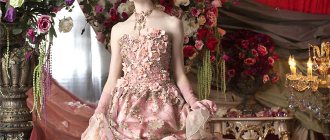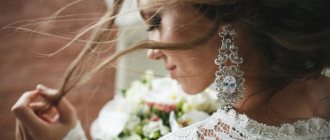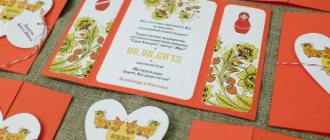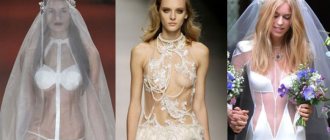History of Russian national wedding costume
In Rus' there was a tradition according to which every bride should sew several wedding dresses for herself in advance. One was intended for the wedding procedure, the other for matchmaking, and the third for the feast. Brides tried to make their outfits as noticeable as possible. Gold embroidery, stones and pearls were used for decoration. Due to the abundance of decor, the weight of the dress exceeded 5 kg.
Until the beginning of the 19th century, wedding sundresses were not white, but red. They were worn on a snow-white shirt. The sundress had a high waist, which made it possible to hide any features of the figure.
Russian folk wedding dress served as a reflection of the family's wealth. It was uncomfortable to move around in it, but visually the outfit was very attractive. According to folk traditions, Russian wedding dresses had to be complemented with a kokoshnik. Girls from poor families used a wreath of flowers instead.
Russian wedding dress
Russian wedding folk costumes are of particular cultural value. They are part of the history of our country, however, even in modern times, Russian wedding dresses arouse keen interest. Russian style and its unique wedding traditions remain a source of inspiration for many designers, and, of course, modern brides and grooms.
Features of Russian wedding costume
Russian wedding suits differed from everyday clothes, first of all, in their color scheme, materials of manufacture, and decor. Every detail of the outfit (and there were many of them - a wedding suit in Russia was multi-item ) had its own meaning. Key differences also include the way they are worn. As for the cut, it was approximately the same as for everyday clothes - loose, straight, not focusing on the features of the physique.
Russian dress with Mstera embroidery
Natural home-made fabrics - linen, wool - were chosen as materials for making wedding dresses. Wedding shirts were made from flax, thin and light, and brides' sundresses were made from denser fabrics.
Dress in Russian style
The choice of material depended on the wealth of the bride's family. Girls from wealthy families could afford clothes made from expensive purchased materials - velvet, brocade, silk. The clothes of brides from peasant families were made from simple fabrics, but they looked no less luxurious - due to the exquisite decor , which was the embodiment of the unique talent of Russian needlewomen. As you know, it was peasant girls who perfectly mastered the art of decoration. And they most clearly showed their amazing talent in decorating wedding dresses.
Unique sundress decor
Russian style wedding
The basis of a bride's wedding dress in Russia was a sundress . These clothes were decorated with gold and silver threads, beads, and bright braid. The most beautiful, of course, were the sundresses of brides from rich, noble families. They were made from luxurious fabrics, including brocade, and decorated with natural pearls and valuable fur. Spectacular and expensive decor made the clothes not only beautiful, but also quite heavy: the sundresses of rich brides could weigh about 10 kg or even more.
Russian costume
Over the sundress, brides often wore shortened soul warmers - clothes whose cut resembled modern jackets. Soul warmers were also decorated - mainly with gingham and textured embroidery. Another element of a wedding outfit is a wedding shirt. In different regions of the country it was customary to decorate such clothes in different ways. Shirts also differed in cut: they could be long, short, narrow, wide, some items of clothing had slits on the sides.
It was customary to wear several skirts under the bride’s sundress at once in order to give visual volume to the figure. Skirts were also used as underwear.
Headdresses of Russian brides
The invariable attributes of women's wedding attire in Rus' were headdresses, which were worn on the hair, loose, or braided into neat braids. Special decorations were provided for braids - braids , which were beautiful ribbons with embroidery, natural pearls, openwork lace, beads, and massive pendants.
nakosnik
Nakosnik
The bride could wear one braid until the wedding, and after that she braided her hair into two braids that wrapped around her head. After the wedding, the girl put on a headdress appropriate to her status - a warrior, a kokoshnik, a magpie. Like other elements of wedding costumes, kokoshniks had luxurious decor. Of particular value were kokoshniks with pearls, which looked like real works of art. The attitude towards them was appropriate: pearl kokoshniks were revered as family heirlooms and passed on from generation to generation.
maiden crown and braid
kokoshnik, embroidery with stones and glass on gold embroidery
Wedding crown
Maiden's crown
Bride's belt
A detail such as a belt . Belts placed an advantageous emphasis on the beauty of the female figure and its shape. Such accessories also performed practical functions - they held clothes in place. For wedding dresses, elaborately decorated belts made of dense material were chosen. The method of tying the belt depended on the length of the accessory. In some areas, it was customary for brides to wear several belts at once - it was believed that this way the outfit looked richer and more impressive. The belts were tied in a knot; their ends could be twisted.
Groom's outfit
As for the groom's Russian wedding attire , it was the same in all regions of the country. The main elements of the costume were cloth trousers, a shirt with beautiful embroidery and a belt. Costumes were often complemented by fur coats and warm, beautifully embroidered caftans - regardless of the time of year. At the wedding, the groom stood, belted with an embroidered towel.
kaftan
shirt had to be decorated. There were special requirements for the decor - red embroidery (if the shirt was white) along the hemline and on the sleeves. The chest area was also decorated with embroidery. Bright red shirts were also common and looked especially festive. The color of the groom's trousers was not of fundamental importance, but preference was also given to bright colors.
Interesting fact: the groom's shirt was embroidered by his bride. It was customary for girls in Rus' to accompany the process of embroidery with prayers: thus, the girl gave her betrothed a kind of message through the pattern, wishing him love, prosperity, and health.
The cut of men's wedding clothing has remained unchanged for many centuries. Small changes concerned individual elements of clothing, for example, the collar. The kosovorotka, which many today associate with the national men's costume, appeared relatively late. Rather, men's shirts with a straight cut at the neckline can be considered primordially Russian.
Wedding dress as a tradition
Almost every element of a wedding dress in Rus' had a special meaning and was deeply symbolic. It is noteworthy that it was preserved. Despite the difficult times that the country was going through, the traditions associated with Russian weddings were carefully passed down from generation to generation. In many ways, thanks to this they were preserved. Many modern girls, getting acquainted with the traditions of Russian wedding costume, often notice familiar features and elements.
Russian wedding attire today
Russian-style weddings are becoming increasingly popular. The bride in a kokoshnik, the groom in a beautifully embroidered caftan - something that has long been no longer considered exotic, a manifestation of kitsch. Many newlyweds opt for national costumes, abandoning the usual formal wear, which has become boring.
Russian wedding costume
Modern brides and grooms are attracted by the originality of the national wedding costume, its brightness, color, and unique decor. Spectacular, beautiful dresses in the Russian style create a truly festive atmosphere at a wedding, creating a special mood for the bride, groom and their guests. Everyone who attended wedding celebrations in the Russian style notes: national dresses truly adorn the newlyweds. Russian wedding clothing emphasizes the femininity and beauty of the bride and emphasizes the masculinity of the groom.
Russian style wedding
Modern wedding dresses in Russian folk style
Traditional folk colors are also used in modern wedding dresses. Fashion designers are reworking ethnic motifs in a new way, experimenting with textures and colors.
Advantages of stylized wedding dresses:
- Russian wedding style looks festive and impressive. It will highlight the beauty and femininity of the bride.
- With the help of a bright dress and the right decor, you can create a themed wedding. Compliance with national customs will allow you to immerse yourself in your native culture.
- Slavic wedding dresses are suitable for girls with any body type. They do not focus on figure flaws.
Other useful articles:
Incendiary and cheerful wedding in Russian folk style
Wedding in Russian style with a modern twist
Russian wedding decoration (photo)
Scenario and decoration of a wedding in Slavic style
White dresses with trim
Elements of folk culture can be combined with modern trends. To do this, you should pay attention to the white wedding dresses of the bride in the Russian style. The designers presented a variety of models to choose from to suit every taste. The wedding dress can be decorated with embroidery in golden, red or blue shades. Bright decorative inserts will also look appropriate. Photos of wedding dresses with embroidery can be seen here.
A Russian wedding dress for an A-line bride would also be a suitable option. It will hide excess volume in the lower part of the figure and focus attention on the chest. To visually increase your height, you should pay attention to models with vertical patterns. The highlight of the look will be open shoulders or a deep neckline.
Dresses decorated with beads or imitation stones will fit well into the Russian folk image. Shining shimmers will create a festive atmosphere. Traditional patterns can be used as a pattern on fabric.
Sundress in Russian style
Russian wedding sundress is made from brocade or linen. Its length can reach the knees or the floor. The cut can be either loose or flared from the chest. A characteristic feature of sundresses is luxurious embroidery with ethnic motifs. The decor can also be a printed design in Gzhel or Khokhloma.
A sundress in a traditional Russian style is suitable for both cool and warm weather. In the first case, you need to put it on a thick white shirt. In summer you can wear the outfit on your naked body.
HISTORY OF THE WEDDING DRESS: WHY IS IT WHITE?
The history of the wedding dress goes back to antiquity, but the traditional white dress with a veil appeared relatively recently - in the 19th century. How did the history of the wedding dress develop in Russia and why is it still white?
The history of the wedding dress goes back several hundred years. The bride's festive clothes changed every now and then, following fashion; in addition, this outfit was not always white. What was the history of the white wedding dress? Before a white dress with a long veil became a traditional outfit for brides in most countries of the world, it was by no means a short journey, but since ancient times it has been a special outfit for every girl.
The very first wedding dresses were not even dresses at all: in the ancient world, dresses for such a celebration were made from grass and flowers and decorated with pearls or beautiful shells. In Ancient Greece, young brides were dressed in peplos - the most common women's clothing made of light sleeveless fabric, decorated with two clasps on the shoulders, and the richer the bride's family, the more elegant these clasps were. The bride's head was covered with gold cloth, which symbolized sunny joy, wealth and happiness. Since in Ancient Egypt, everyday women's clothing was a kind of sundress that tightly fitted the body (it was called kalaziris), they got married in it. In those days, the bride was distinguished from other women not by her clothes, but by the jewelry that could be seen on her in abundance - all kinds of talismans, amulets, bracelets, tiaras, etc.
In ancient Rus', brides wore either a red sundress or a traditional white shirt, decorated with embroidery, with a poneov, a kind of predecessor to the skirt (the choice of outfit depended on the region). Sometimes an apron was also worn over the poneova. Since it was believed that it was the red color that protected from evil spirits, everything on the bride - ribbons, embroidery, trimmings - was only red. This outfit lasted until the 18th century: it was then, thanks to the reforms of Peter I, that Russia began to adopt European fashion. In villages and poor families, brides were dressed in the traditional way in the 19th and even at the beginning of the 20th century, although in general, starting from the 18th century, the history of wedding dresses in Russia kept pace with the wedding fashion of European countries. As for Western medieval wedding clothing, brides' dresses were ordinary festive clothing, in accordance with the fashion of the time. The tradition of wearing a new dress to a wedding appeared only in the 15th century. In wealthy families, wedding dresses were supposed to demonstrate the social status of the bride, so they were sewn in the latest fashion from exclusive fabrics and trimmed with expensive furs. The color of the dress could be absolutely any; scarlet, red or purple were especially popular, although wedding dresses were made in dark green, pink, brown, and even black. The choice of color was largely due to practical considerations: medieval streets were very dusty and dirty, and doing laundry in those days was not a cheap pleasure. And wedding dresses then, unlike today, were not a “one day” outfit; after the wedding, brides wore them several more times and for other special events.
The era of neoclassicism brought fashion for very light, although not yet white, wedding dresses. At this time, excavations of the city of Pompeii were taking place and European women were treated to ancient sculptures and frescoes, in which they saw ancient fashionistas in loose-fitting dresses. Corsets and full skirts are becoming a thing of the past; now brides are more likely to resemble ancient Romans: high waists, small sleeves and draperies made of light fabrics. The date of “birth” of the traditional white wedding dress is considered to be February 10, 1940: it was then that Queen Victoria’s wedding to Duke Albert took place in England. At the wedding ceremony, the bride appeared in a sparkling white dress with a long train (12 daughters of English lords were invited to carry it). The official photograph of the royals in their wedding dresses was published and was very popular, and brides, imitating the Queen, began to choose white for their wedding dresses, which became the highest expression of fashion, style and chic. The industrial revolution that took place at that time came in handy - thanks to department stores opening everywhere, every girl had the opportunity to become a fashionable bride in white. Thus began the history of the white wedding dress. The time before the outbreak of World War I is often called the “Belle Epoque” (Le Belle Epoque). The “modern” style dominates in fashion; brides are returning to corsets, which create a clear silhouette with a slightly elongated waist, while skirts look like a flower lowered down. The bride's dress can be compared to the curved stem of a lily, a favorite symbol of modernists. In the war and post-war 40s of the XX century, naturally, there was no time for wedding dresses; people got married without any outfits at all, but in the 50s, when the shortage of fabrics disappeared into oblivion, brides were seized by a lace madness, although the dresses themselves were the embodiment of the very modesty.
The idea that a bride should look like a princess in a white dress was finally established in 1956, when the “wedding of the century” was broadcast on television: the marriage of actress Grace Kelly to Prince Rainier III of Monaco. The bride's unique outfit was made of white silk taffeta and antique rose lace. The wedding fashion industry has been developing at a breakneck pace since then, and the so-called “Wedding Fashion Week” is held annually in different countries. The most famous of them is held as part of Couture Fashion Week in New York.
Dresses with embroidery and patterns
Traditional Russian wedding dresses are usually decorated with ethnic patterns. The outfit can have a full or tight skirt. As a talisman, Slavic girls wore a shirt under it. She had to protect the bride from dark forces.
The patterns on the Slavic wedding dress had a certain meaning. Snowflakes symbolized the family hearth. The Lada Cross guaranteed the newlyweds healthy offspring and protected them from the evil eye. The Christmas tree was considered a symbol of close ties with relatives.
Story
Russian folk wedding dress has a centuries-old history. In the old days in Rus', the bride had to have four outfits:
It is noteworthy that the wedding attire of ancient Russian peasant women did not differ significantly from the attire of noble girls. Moreover, the bride was required to sew her wedding dress herself. Even a noblewoman or a merchant's wife, before her wedding, sat down to needlework and made herself a wedding suit - rich families or not, it no longer played a role here.
The reign of Peter I made its own adjustments not only to the policies of Russia, but also to the customs of the country. Traditions, rituals and ceremonies changed. All segments of the population began to follow European fashion, and brides began to wear dresses similar to those worn in other countries.
The fashion for the traditional Russian wedding suit gradually faded away. But today it is again popular among newlyweds. Perhaps a completely modern girl would not risk repeating an old outfit. But certain details of jewelry and traditional decor in the wedding look are present in the clothes of many brides.
The sundress was the basis of the attire. It was decorated with gold and silver embroidery, decorated with pearls, beads and braid of bright colors. The wealthy newlywed shone in a sundress trimmed with valuable fur. The girl looked rich in a beautiful wedding dress. It should be noted that it was not so easy to be in such an image all day, since it weighed a lot due to the abundant decoration.
On top of the sundress was worn a soul warmer, embroidered with gimp or national ornaments. And skirts were worn under the sundress to add volume to the outfit.
Particular attention was paid to headdresses - kosnik, povoinik, kokoshnik, magpie. Each of them had its own meaning and was richly decorated with pearls and gimp. And pearl kokoshniks were considered a family heirloom, they were passed down from generation to generation.
Choice of color, fabric and cut
The styles of wedding dresses in the Russian style are full of variety. Fashion designers were able to adapt even an elegant year model to it. When choosing a cut, the bride will not have to take into account the nuances of her figure. Slavic wedding clothes will decorate a girl with any parameters.
Common styles of Slavic wedding dresses include:
- A-silhouette;
- straight cut;
- lush;
- shortened options.
The material for sewing an outfit in Russian folk style should be linen or cotton. Synthetic fabrics will be inappropriate. You can use lace for decoration.
The main color in a wedding dress can be red or white. The decor is made in golden, blue, red or green tones. It is advisable that color combinations be contrasting. This will make the image bright and festive.
Models you want to wear
What is a dress in Russian folk style? The answer is easy and difficult at the same time. The peculiarity of folk cut was the practicality and convenience of details:
- gusset allows you to add freedom of movement;
-the obliquely sewn sleeve forms a soft shoulder line;
-loose fit maintains comfort under clothing;
-convenient neck slit with ties.
The peculiarity of such details allows you to create a favorable look for any type of figure. A slender figure will sparkle with the colors of tenderness and lightness. The volumetric type of addition will acquire advantageous features that focus attention only on the winning details. By adjusting the waist level with a woven belt, you can create various compositions based on the requirements for the final result.
Accessories and shoes for the bride's image in the Russian style
Accessories play an important role in the image. The style of the outfit is complemented with a wreath of wild flowers, a shawl with fringe or a kokoshnik. The traditional Russian look also includes lace capes and a scarf tied on the head. In winter, a fur muff will come in handy.
Modern decorations should not be used. It is enough to wear pearl beads around your neck. The bride can weave satin ribbons into her hair.
Shoes should be selected taking into account the weather. In the cool season, red boots embroidered with beads or stones will be popular. Felt boots are suitable for a winter wedding. For the summer, you should take closed shoes with a pointed toe.
Makeup and hairstyle
A Russian wedding presupposes a natural appearance of the bride. Makeup should be done in natural shades. You can do without it. A light blush and sparkle in the eyes will be the best decoration of the image.
You will have to give up intricate hairstyles and stylish styling. You can leave your hair loose or braid it. The finishing touch of the look is a bright headband.
Groom suit
Russian wedding suits of the bride and groom should be in harmony with each other. The groom's outfit consists of a shirt, trousers and a bright belt. The color scheme should match the bride's dress. If preference is given to a white shirt, the embroidery is done in gold or red.
A wedding dress in the Slavic style will help create a truly memorable holiday. When composing an image, it is important to observe moderation in every detail. The whole flavor lies in the ethnic patterns and simple cut of the outfit.
history of women's wedding costume in Rus' (research work)
2 slide
Modern brides sometimes find it difficult to choose the right wedding dress from the many different models. Sometimes we don’t even think that such a variety of styles and styles is due to centuries of history. Since ancient times, in the era of antiquity, women paid special attention to their wedding attire. But is it possible to combine all centuries-old traditions in one dress? Has anyone tried to do this and what was the success of the project. To find out I will do my own research and design a wedding suit.
3 slide
To develop my own sketches, I decided to study the history of the wedding suit, starting from ancient times.
It was impossible to miss the history of the wedding dress of ancient Rus'
In Ancient Rus', the function of a wedding dress was performed by a colorfully embroidered sundress and shirt. Most often, the color of the sundress was red - the traditional color of joy in Rus'. The word “red”, in addition to its color meaning, previously also had the meaning of beautiful.”
In the old days, it was believed that a girl who gets married is “dead” to her past girlhood and to her family, and after marriage she goes to her husband’s family.
4 slide
In the 15th century, wedding dresses were made of brocade and embroidered with pearls. The weight of such an outfit could be 15 kg! Until this time, all Russian brides dressed up in folk costumes of a wide variety of colors. The wedding dresses of noblewomen and simple peasant women differed only in the high cost of fabrics and precious stones, which abounded in embroidery. Throughout the wedding ceremony, the girl had to change her outfits.
5 slide
I wanted to pay special attention to the wedding costume of our native lands. In order to better understand its symbolism, I visited the museum and learned detailed information from the guide.
It turns out that the main distinguishing feature of the Belgorod costume is the skirt (poneva), which a girl can wear only on her wedding day (When in other regions the poneva was worn on the day of the first menstrual cycle).
The costume also consists of a shirt, an apron, a belt, a magpie (within which the horns are hidden) and an ornament - a comb (given by the mother-in-law and it was believed that the number of suns on the comb, the number of children there will be in the family).
The Belgorod suit is a special outfit, protected by amulets and accompanying good luck in family life. Each character is significant and very important.
6 slide
Each symbol is a special sign, a talisman. For example, the intricate pattern on the skirt symbolizes the family tree: “He and she together,” a small tree and a large one. The vertical stripes symbolize the path of life, and the cells symbolize plots of land. The horns hidden under the magpie are a connection with the ancient deity - the moose cow. Every detail embroidered on the dress is created in a special rhythm, in special harmony with nature. As Yesenin wrote: “The tree is the true religion of the thought of Russian people.”
7 slide
And in the 19th century, “empty” dresses came into fashion, amulets and significant symbols disappeared, patterns became mere decoration.
The tradition of the white dress is not very old (about 200). Wedding dresses of the 19th century are a real work of art. They were sewn using a unique lace - blonde. This material had a refined golden hue. The finest material was very light and fragile, which gave the image of the bride even more sublimity. The photo shows examples of outfits that are part of the centuries-old history of the wedding dress. It was the 19th century that became “revolutionary” and innovative for wedding dresses. During this era, fashion changed frequently, new styles were created, which served as the basis for the developments of modern designers.
8 slide
The first in Europe to risk walking down the aisle in a white dress was Margarita of Valois, Queen Margot. And soon all the brides on the continent dressed in white. But only if they were getting married for the first time. During the second marriage, a woman (neither divorced nor widowed) had the right to a white robe. This fashion lasted for more than two centuries. But by the end of the second millennium, wedding horizons turned red again. At first, very timidly, here and there, brides in soft pink began to appear, and they were looked at with even more surprise. But fashion is inexorable. Remembering the orange bedspreads of brides in Ancient Rome and Russia at the end of the 19th century, when the folk wedding costume shimmered with all shades of red, she returned to the color, the name of which means beautiful (remember the Russian red maidens).
Slide 9
And at the beginning of the 18th century, Peter the Great ordered all of Russia to follow European fashion. Traditional Russian wedding attire existed in villages until the 19th century, and in some places even until the 1917 revolution. Actually, since the 18th century, Russian wedding fashion has practically kept pace with European ones. Russian empresses were married in rococo style dresses.
10 slide
The “Empire” style did not bypass Russia either. Ballroom and wedding dresses were made in this style before the War of 1812. In the middle of the 19th century, French wedding dresses appeared in St. Petersburg and Moscow - with a huge amount of lace, on crinolines, with corsets embroidered with pearls, gold and silver.
11 slide
Since 1917, church weddings were abolished, registry offices appeared, and wedding fashion was forgotten for several decades. The newlyweds came to register their relationship in the registry office in casual clothes. Only during the time of the New Economic Policy (1921-1928) did some semblance of a wedding dress appear. In clothing of that time, practicality and “reusability” were valued.
Soviet brides, like European ones, wore hats with a veil or veil in the 60s. In wedding photographs of the 70s, you can see quite simply dressed brides: either in non-wedding, ordinary dresses, or in wedding dresses - white, straight cut, with unpretentious, monochromatic trim with inexpensive lace or ruffles, modest wreaths and a single-layer veil.
12 slide
The 80s and post-perestroika period are the times when foreign wedding dresses first appeared in the USSR. After the collapse of the USSR, a flood of imported goods poured into the country and, of course, wedding dresses were among them.
Slide 13
Attempts by designers
Slide 14
After doing research and understanding centuries-old wedding suit fashion trends, I tried to develop my own designs. I tried to combine several eras, respecting traditions and external aesthetics.
Each dress carries a life, an era, a heritage, and each remains unique in its own way. Any century that gives birth to a new costume makes it special, always beautiful, even if sometimes simple or, on the contrary, too complex. The dress contains a huge history of the country, region, family. It is impossible to connect all eras together aesthetically and elegantly, but you can breathe new life into that “ancient”.
Thank you for your attention!










